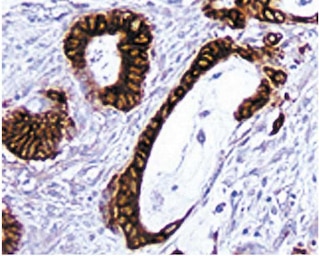Old Browser
This page has been recently translated and is available in French now.
Looks like you're visiting us from {countryName}.
Would you like to stay on the current country site or be switched to your country?




Regulatory Status Legend
Any use of products other than the permitted use without the express written authorization of Becton, Dickinson and Company is strictly prohibited.
Preparation And Storage
Recommended Assay Procedures
Immunohistochemistry: The RB40.34 antibody is recommended to test for immunohistochemical staining of acetone-fixed frozen sections. Tissues tested were mouse spleen and thymus. The antibody stains thymocytes, lymphocytes, neutrophils, eosinophils, and monocytes. The isotype control recommended for use with this antibody is purified rat IgG1 (Cat. No. 553993). For optimal indirect immunohistochemical staining, the RB40.34 antibody should be titrated (1-10 to 1-50 dilution) and visualized via a three-step staining procedure in combination with biotonylated polyclonal anti-rat Igs (multiple adsorbed) (Cat. No. 559286) as the secondary antibody and Streptavidin-HRP (Cat. No. 550946) together with the DAB detection system (Cat. No. 550880). The clone RB40.34 is not recommended for formalin-fixed paraffin embedded sections.
A detailed protocol of the immunohistochemical procedure is available at our website, http://www.bdbiosciences.com/support/resources
Product Notices
- Since applications vary, each investigator should titrate the reagent to obtain optimal results.
- Caution: Sodium azide yields highly toxic hydrazoic acid under acidic conditions. Dilute azide compounds in running water before discarding to avoid accumulation of potentially explosive deposits in plumbing.
- Source of all serum proteins is from USDA inspected abattoirs located in the United States.
- An isotype control should be used at the same concentration as the antibody of interest.
- This antibody has been developed for the immunohistochemistry application. However, a routine immunohistochemistry test is not performed on every lot. Researchers are encouraged to titrate the reagent for optimal performance.
- Please refer to www.bdbiosciences.com/us/s/resources for technical protocols.
Companion Products




The RB40.34 monoclonal antibody specifically binds to mouse P-selectin (CD62P), a 140 kDa protein which is expressed on activated platelets, activated endothelial cells, and megakaryocytes. P-selectin mediates the adhesion of neutrophils and monocytes to activated platelets and endothelial cells, mediates leukocyte rolling, and is involved in the migration of leukocytes into inflamed tissues. CD24 and CD162 (PSGL-1) are ligands of CD62P. mAb RB40.34 can block mouse P-selectin binding to its ligands in vitro and in vivo.
Development References (4)
-
Aigner S, Ruppert M, Hubbe M, et al. Heat stable antigen (mouse CD24) supports myeloid cell binding to endothelial and platelet P-selectin. Int Immunol. 1995; 7(10):1557-1565. (Biology). View Reference
-
Bosse R, Vestweber D. Only simultaneous blocking of the L- and P-selectin completely inhibits neutrophil migration into mouse peritoneum. Eur J Immunol. 1994; 24(12):3019-3024. (Immunogen: Blocking, ELISA, Flow cytometry, Immunoprecipitation). View Reference
-
Ley K, Bullard DC, Arbones ML, et al. Sequential contribution of L- and P-selectin to leukocyte rolling in vivo. J Exp Med. 1995; 181(2):669-675. (Clone-specific: Blocking). View Reference
-
Yang J, Galipeau J, Kozak CA, Furie BC, Furie B. Mouse P-selectin glycoprotein ligand-1: molecular cloning, chromosomal localization, and expression of a functional P-selectin receptor. Blood. 1996; 87(10):4176-4186. (Biology). View Reference
Please refer to Support Documents for Quality Certificates
Global - Refer to manufacturer's instructions for use and related User Manuals and Technical data sheets before using this products as described
Comparisons, where applicable, are made against older BD Technology, manual methods or are general performance claims. Comparisons are not made against non-BD technologies, unless otherwise noted.
For Research Use Only. Not for use in diagnostic or therapeutic procedures.
Report a Site Issue
This form is intended to help us improve our website experience. For other support, please visit our Contact Us page.